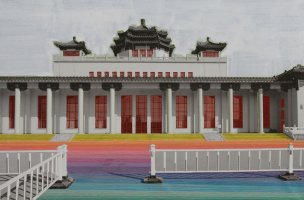《烏托邦現實結合部:談林菁菁創作》
1970年出生於上海的當代藝術家林菁菁,即屬於所謂的中國70後世代,「70後」是見證中國步入快速社會進程和經貿發展並充份參與其中(或可指涉改革開放)的一代。
在中國,人們言談間往往使用「城鄉結合部」去定義城市與鄉村的融合交界,該詞並描繪出群體正在經歷和感受的日常環境變遷,也涵蓋了個體的視覺和身體經驗,永恆不變的卻是一直更迭的狀態。一旦我們嘗試拉寬維度去觀察自身視野,這種「結合部」樣態真的僅是亞洲特有的嗎?抑或普遍地深植於所有人的當下?即全球化在不同地域、族群造成各異的現象,人類在各層面無時無刻都沉浸在一種過渡性質的結合部狀態,個體對自身與世界的關係感到不安和困惑,包括近期被提出的元宇宙,個體需要思考未來該如何因應的事物又多了一項,而藝術家林菁菁十多年來的創作軌跡頗切合不間斷變動的大環境體質。
疫情蔓延之際,林菁菁於2021年著手創作題為「烏托邦現實」的新系列架上作品,烏托邦、現實二詞昭示了藝術家為新階段作品內建的核心質地,這兩個意象的疊加同時也重申了林菁菁長期熱衷探討的「悖論」之無所不在(omnipresence),烏托邦路線的想像形塑了大眾的日常生活,假設烏托邦代表的是人類對美好生活的追求和期待,透過前沿科技、都市更新、交通工具......等日新月異的手段,最終「現實」會成為一種結果(result)或是後果(consequence),這兩者像是「城、鄉」彼此拉鋸,只得共處、共存。
林菁菁的原生家庭具有科研背景,成長環境驅使她對許多非典型觀念裡具有女性特質的事物產生興趣,尤其是耳濡目染的科技領域事物,科技乍看鮮少與藝術結盟,但在這兩個領域,無論是體驗者或是生產者,都需要保持高度的自我升級能力。回到藝術家的創作歷程來看,林菁菁未曾以特定單一形式立足於當代藝術圈,行為、裝置、繪畫、印刷和影像在她的創作中互為表裡,每種媒材藉由不同題旨一次次地自我蛻變,這確實是林菁菁的獨特能耐,譬如她的「絲綫縫紉」已不僅僅是繪畫媒材,當早期出現在《玫瑰 玫瑰》系列(2008)攝影中,我們體認到縫紉行為本身映射出藝術家企圖表達的縫補與傷害的赤裸悖論關係,在往後每回縫綫的登場都呈現更新升級版的作用,無論是在《傾盡所有,我只為了那一點陽光陽光陽光》(2014)、《中國夢》(2015)和正在進行中的《烏托邦現實》(2021-2022)系列裡,光滑油亮的縫綫在藝術家的調度之下總發揮出不同效果,有時候是強調、有時則是消解,又許多時候縫綫的走向則是引導觀眾參與藝術家的內在思辨;除了上述媒材,文字/文本在其創作脈絡上也有其關鍵性,2017年藝術家在德薩畫廊香港空間的個展「脫軌」就充份運用了文字這樣充滿能動性的媒材,文字/文本得以傳遞思想論證,綜合觀之,可說林菁菁的哲學思想者身份在前,視覺創作者身份在後。
林菁菁對科技的長年關注藉由「烏托邦現實」較過往更具體、壯闊地表現出來,從如夢境一般的不明飛行物、太空人到陌生自然地景,自20世紀至今人類對外太空的探索和追問未曾停歇,事實是曾親臨外太空的人少之有少,但大眾對外太空相關圖像的著迷伴隨科技的精進一再挖深,人類甚至開始憧憬並且設計移居至另一個星球的可能方法,新媒體、資訊吸引大眾去想像更多,想像卻導致我們感覺自己持續地身在別處。
Rose Rose, 2009 ©Lin Jingjing
All I Need Is Sunshine Sunshine Sunshine 3, 2014 ©Lin Jingjing
All I Need Is Sunshine Sunshine Sunshine 4, 2014 ©Lin Jingjing
China Dream: Waiting For a Miracle, 2015 ©Lin Jingjing
“An Integration of Utopia and Reality: Commentary on the Works of Lin Jing Jing”
Born in Shanghai in 1970, contemporary artist Lin Jing Jing is part of the so-called post-70s generation in China, a generation that witnessed and participated in China's rapid social progress as well as economic and trade development (or in other words a reformation and opening up of the nation).
In China, common discourse often employs the term "urban-rural integration" to define the intermixing space between urban and rural areas. This term depicts the daily environmental transformations that collective groups of people encounter and feel, and also encompasses the visual and physical experiences of individuals in a state where the only constant is change. Globalization has led to a rise in peculiar phenomena within different regions and ethnic groups; human beings are continuously and at every level immersed in a state of transitional integration. Individuals feel uneasy and perplexed about their personal relationship with the world, including the recent iteration of the metaverse, which adds one more thing to what individuals must consider in contemplating the future. For more than 10 years, the artist Lin Jing Jing’s creative works have been inexplicably filled with the ever-changing nature of the environment at large.
In the midst of the growing pandemic, Lin created a new series of drawings in 2021 entitled "Utopia Reality.” The words “utopia” and “reality” indicate the core essence built into a new phase in this artist’s work, and the superimposition of these two visions also reaffirms Lin’s long-standing fascination with exploring the omnipresence of "paradox.” The imagined road to utopia has been a guiding force in molding the daily lives of the public; If utopia represents mankind's pursuit and expectation of a good life, through cutting-edge technology, urban renewal, transportation, etc., “reality” ultimately will become its result or consequence. These two words are like the back-and-forth struggle between “urban” and “rural,” which can only coexist in symbiosis.
Lin Jing Jing grew up in a family with a background in scientific research. Her upbringing led her to develop an interest for unconventional perspectives in matters related to feminine qualities, especially through her exposure to subjects in the field of technology. Although technology is rarely aligned with the arts, every participant in these two fields, whether as consumer or producer, must maintain a great capacity to elevate oneself. In an examination of her art anthology, Lin has never established herself within contemporary art circles through one specific medium; performance, installation, drawing, printing, and video imaging are simultaneously displayed in her works, with each medium metamorphosing again and again through the adoption of different topics. This is truly Lin’s defining trait. For example, Sewing with Silk Thread does not simply use the medium of painting. In its appearance in the early Rose Rose series (2008), we recognize that the act of sewing itself projects the artist's attempt to express the naked paradox within the relationship between mending and damaging. Each subsequent appearance of sewing elevates its impact, whether in “All I Need is Sunshine Sunshine Sunshine” (2014), “China Dream” (2015), or the current run of “Utopia Reality” (2021-2022), the smooth shine of the sewing thread exudes varying effects under the artist’s modulation. Sometimes for emphasis, other times for dissipation, and still there are moments when the direction of the stitching serves to guide audiences to participate in the artist’s inner reflections.
The years of attention Lin has paid to technology is exemplified through Utopia Reality more fully and robustly than ever before, as shown by dream-like UFOs to astronauts in strange natural landscapes. Since the 20th century, humankind's exploration and inquisition of outer space has never ceased. The fact remains that the number of people who have personally visited outer space is incredibly small. Nevertheless, the general public continues to encourage the advancement of technology as they avidly view images related to space. Humans are even beginning to envision and design possible ways to migrate to other planets. New media and information might expand greater imaginations among the public, but also lead us to experience that we are constantly anywhere else but here.





